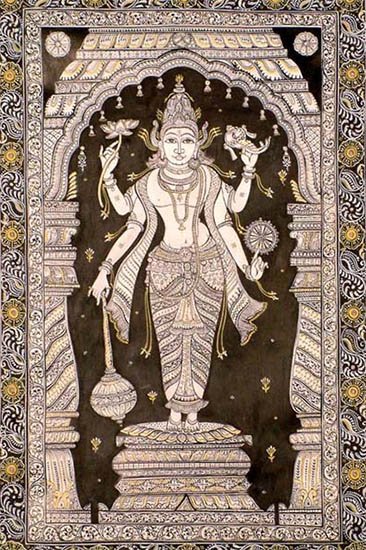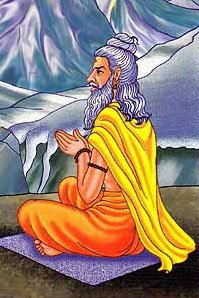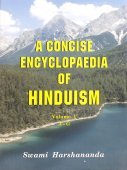Ekanamsha, Ekānaṃśā, Eka-anamsha: 9 definitions
Introduction:
Ekanamsha means something in Hinduism, Sanskrit. If you want to know the exact meaning, history, etymology or English translation of this term then check out the descriptions on this page. Add your comment or reference to a book if you want to contribute to this summary article.
The Sanskrit term Ekānaṃśā can be transliterated into English as Ekanamsa or Ekanamsha, using the IAST transliteration scheme (?).
In Hinduism
Shilpashastra (iconography)
Source: Google Books: Iconography of BalarāmaEkānaṃśā (एकानंशा).—This goddess is the sister of Kṛṣṇa and Balarāma. She came to be known as Ekānaṃśā because she was born of one part (aṃśa) of Viṣṇu himself. The Mahābhārata describes how once Balarāma and Kṛṣṇa received her and how attractive she appeared between them. This description fully tallies with her sculptural representations, in which she is always flanked by Balarāma and Kṛṣṇa.

Shilpashastra (शिल्पशास्त्र, śilpaśāstra) represents the ancient Indian science (shastra) of creative arts (shilpa) such as sculpture, iconography and painting. Closely related to Vastushastra (architecture), they often share the same literature.
Purana and Itihasa (epic history)
Source: Journal of the American Oriental Society: The Harivaṃśa, the Goddess EkānaṃśāEkānaṃśā (एकानंशा) is the name of a female Goddess mentioned in the Harivaṃśa and is also referred to as Nidrā or even Kālī. The role of this female is closely linked to that of her two male companions (Kṛṣṇa and Saṃkarṣaṇa). The interactions of the Saṃkarṣaṇa-Ekānaṃśā-Kṛṣṇa triad are in fact presented in at least three different circumstances in the Harivaṃśa.

The Purana (पुराण, purāṇas) refers to Sanskrit literature preserving ancient India’s vast cultural history, including historical legends, religious ceremonies, various arts and sciences. The eighteen mahapuranas total over 400,000 shlokas (metrical couplets) and date to at least several centuries BCE.
Kavya (poetry)
Source: Wisdom Library: KathāsaritsāgaraEkānaṃśā (एकानंशा) is one of the epithets of Durgā, according to the Kathāsaritsāgara, chapter 53. Accordingly, as Vīravara praised Durgā: “... thou art the principle of life in creatures; by thee this world moves. In the beginning of creation Śiva beheld thee self-produced, blazing and illuminating the world with brightness hard to behold, like ten million orbs of fiery suddenly produced infant suns rising at once, filling the whole horizon with the circle of thy arms, bearing a sword, a club, a bow, arrows and a spear. And thou wast praised by that god Śiva in the following words ... [Ekānaṃśā, etc...]”.
Also, “... when Skanda, and Vasiṣṭha, and Brahmā, and the others heard thee praised, under these [eg., Ekānaṃśā] and other titles, by Śiva well skilled in praising, they also praised thee. And by praising thee, O adorable one, immortals, Ṛṣis and men obtained, and do now obtain, boons above their desire. ”
The Kathāsaritsāgara (‘ocean of streams of story’), mentioning Ekānaṃśā, is a famous Sanskrit epic story revolving around prince Naravāhanadatta and his quest to become the emperor of the vidyādharas (celestial beings). The work is said to have been an adaptation of Guṇāḍhya’s Bṛhatkathā consisting of 100,000 verses, which in turn is part of a larger work containing 700,000 verses.

Kavya (काव्य, kavya) refers to Sanskrit poetry, a popular ancient Indian tradition of literature. There have been many Sanskrit poets over the ages, hailing from ancient India and beyond. This topic includes mahakavya, or ‘epic poetry’ and natya, or ‘dramatic poetry’.
Languages of India and abroad
Sanskrit dictionary
Source: DDSA: The practical Sanskrit-English dictionaryEkānaṃśā (एकानंशा).—the only (day) receiving no part of the moon, an epithet of Kuhū or day of new moon (born together with Kṛṣṇa and worshipped with Kṛṣṇa and Baladeva and identified with Durgā).
Ekānaṃśā is a Sanskrit compound consisting of the terms eka and anaṃśā (अनंशा).
Source: Cologne Digital Sanskrit Dictionaries: Shabda-Sagara Sanskrit-English DictionaryEkānaṃśā (एकानंशा).—f.
(-śā) A name of Parvati. E. aṃśa a part, with the neg. pref. and eka pre-eminent: chief and undivided.
Source: Cologne Digital Sanskrit Dictionaries: Monier-Williams Sanskrit-English Dictionary1) Ekānaṃśā (एकानंशा):—[from eka] f. ([scilicet] kalā) ‘the single portionless one’, Name of Kuhū or the new moon, [Mahābhārata iii, 14129]
2) [v.s. ...] personified as Durgā, [Harivaṃśa; Varāha-mihira’s Bṛhat-saṃhitā]
3) [v.s. ...] Name of Durgā, [Kathāsaritsāgara]
Source: Cologne Digital Sanskrit Dictionaries: Yates Sanskrit-English DictionaryEkānaṃśā (एकानंशा):—(śā) 1. f. Pārvatī.
[Sanskrit to German]
Sanskrit, also spelled संस्कृतम् (saṃskṛtam), is an ancient language of India commonly seen as the grandmother of the Indo-European language family (even English!). Closely allied with Prakrit and Pali, Sanskrit is more exhaustive in both grammar and terms and has the most extensive collection of literature in the world, greatly surpassing its sister-languages Greek and Latin.
See also (Relevant definitions)
Partial matches: Anamsha, Eka.
Full-text: Nidra.
Relevant text
Search found 5 books and stories containing Ekanamsha, Eka-anaṃśā, Eka-anamsa, Eka-anamsha, Ekānaṃśā, Ekanamsa; (plurals include: Ekanamshas, anaṃśās, anamsas, anamshas, Ekānaṃśās, Ekanamsas). You can also click to the full overview containing English textual excerpts. Below are direct links for the most relevant articles:
The Skanda Purana (by G. V. Tagare)
Chapter 18 - The Glory of Ekānaṃśā < [Section 1 - Avantīkṣetra-māhātmya]
Chapter 70 - Index of All Tīrthas (in this Text) < [Section 1 - Avantīkṣetra-māhātmya]
Chapter 19 - Demon Mahiṣa Slain by Durgā < [Section 3b - Arunācala-khaṇḍa (Uttarārdha)]
The Interplay of Arts in Ancient India < [September 1944]
Kathasaritsagara (the Ocean of Story) (by Somadeva)
Chapter LIII < [Book IX - Alaṅkāravatī]
The Padma Purana (by N.A. Deshpande)
Chapter 43 - Gaurī’s Marriage < [Section 1 - Sṛṣṭi-khaṇḍa (section on creation)]
Related products
